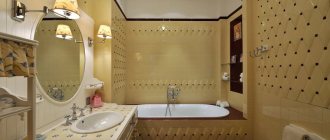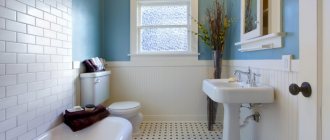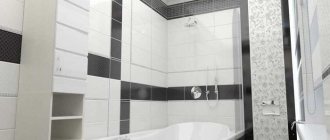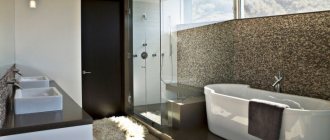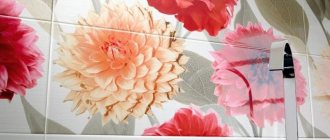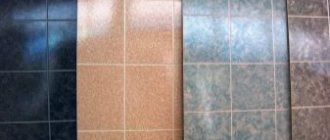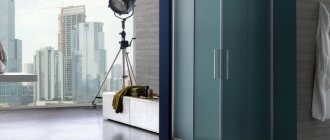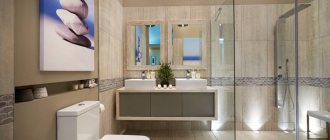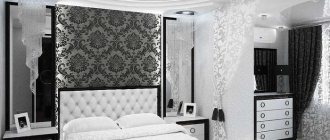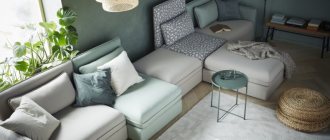Features of using paint in the bathroom
Using the painting method in bathroom design has a number of advantages:
- A wide range of colors allows you to create a unique interior.
- Unlike the labor-intensive and costly task of laying tiles, painting is a quick and inexpensive way to transform a space.
- High-quality modern products create a protective layer, preventing the appearance of fungus and mold.
- Compliance with the stages of painting walls is a guarantee of the durability of the created decorative coating.
Painted walls will help create a unique bathroom interior.
If necessary, you can paint already laid ceramic tiles.
The main thing is that the surfaces are properly prepared, cleaned, sanded and primed.
Painting tools: their advantages and disadvantages
The following tools can be used to paint the surface:
- Brushes of different hardness and width. Suitable for treating small, hard-to-reach areas (the area behind the toilet, shower or bathtub). They may leave unsightly “smears” and smudges, which will disrupt the uniformity of the surface.
- Rollers. Used to cover large areas. They allow you to quickly treat an area of the wall and at the same time provide a uniform layer. It is better to use foam rollers.
- Spray guns. This group includes atomizers and atomizers. The tools work on a similar principle: they spray the composition at a certain distance from the surface under air pressure. Gives a uniform coating. The person himself regulates the degree of coloring and the amount of paint that is spent on each square centimeter. To reduce the consumption of the composition, simply increase the distance between the wall and the spray gun. It is recommended to work in a respirator or a special mask.
Spray guns are considered the most modern option. They are used not only for painting walls, but also for furniture of complex configurations. If a combination of several colors is used, then use masking tape to delimit individual areas.
Which coating to choose
The choice of paints for a sanitary unit is huge. Each option has different advantages and disadvantages of use. Let's look at each type.
Water-based
It attracts with a number of positive properties: it does not contain toxic substances; dries quickly; allows vapor to pass through, so fungus does not develop on painted walls.
Typically, water-based coating is used for painting ceilings and walls in dry rooms. For example, in a nursery or living room.
However, it also has disadvantages. Before painting, you will have to carefully prepare the walls. In addition, it is easily washed off with water, so it is not advisable to use it in the bathroom.
Acrylic
This product is created on the basis of synthetic rubbers. After application, like water-based emulsion, it can be easily removed with water. But once the paint dries, it can only be removed with special solvents.
Dark gray bathroom decorated with acrylic coating
This product has several advantages: it dries very quickly, it has practically no unpleasant odor, so you should not be afraid of allergic reactions, and after drying it becomes one of the most moisture-resistant products. In terms of price and quality, acrylic is one of the best options for painting a bathroom.
If the room has a window that allows sunlight to enter, there is no need to worry about fading. Acrylic is not subject to fading in the sun.
It is especially worth noting the possibility of using this product for any type of surface. This property helps to minimize the time required to prepare the surface before painting. True, acrylic paints do not adhere to painted surfaces. The decorative layer of the old coating will have to be removed.
Latex
It is created on the basis of natural ingredients (rubber juice), is very easy to apply, dries quickly, does not have a strong chemical odor, and is abrasion resistant.
If the durability of the coating is important to you, you should pay attention to latex paint.
A room painted with latex paints retains its original appearance for a very long time. The low consumption and affordable cost of the material are also attractive.
Disadvantages of use:
- careful preparation is required before painting (a thin film of latex emphasizes even the most minor flaws);
- Latex paints are not suitable for painting in unheated rooms.
Oily
If you are ready for a long ordeal with a pungent odor, you can choose this type. Its advantages may outweigh the disadvantages if it is important for you to choose a product suitable for any coating, with a high waterproof rating, uniform application, and at the same time an affordable price.
Oil types allow you to get a deep shade of the walls, even if pastel colors are chosen
The richness of the paint will allow you to create a bright, contrasting design if you combine deep, bold flowers with snow-white fixtures.
Luscious bathroom interior with walls coated with oil paint
However, you should be prepared for the fact that the painted area will take a long time to dry, and the smell will persist for several weeks. It seems good if there is a window in the bathroom - you can get rid of odors with the help of ventilation. But here a new disadvantage emerges - under the influence of sunlight, the oil coating will fade, and in the future it will crack and crumble. Another renovation will be required.
And getting rid of even old, crumbling oil-based coating is not so easy. The video shows how to do this with a minimum of effort.
Glossy
This product is perfect if the room has smooth, smooth walls. Well, or you are ready to make them like that. If both times the answer is no, scroll through the list further. And that's why.
Any flaw in the original site will easily show through the thin coating, the shine of which will only emphasize the terrifying relief.
But perhaps it’s worth taking up plastering and still choosing this type, because it has a number of advantages:
- helps to visually expand the space of the bathroom due to its texture;
- has a high elasticity index;
- creates the effect of a mirror surface;
- painted areas are easy to maintain.
Chlorinated rubber
This product was specifically designed to transform bathrooms, swimming pools and even saunas.
This type will help make your bath not only beautiful, but also safe: it does not contain harmful impurities
Main advantages:
- withstands contact with water well, maintaining its original appearance;
- does not change color when exposed to ultraviolet radiation;
- does not contain toxic substances.
The main disadvantage of chlorinated rubber is the high cost of the material. The repair budget will have to be drawn up in advance.
You should also be prepared for the fact that painting requires careful preliminary preparation of rough surfaces.
Alkyd
It is resistant to abrasion (it is often used for painting building facades). Walls painted with alkyd paint can be washed using chemicals.
The painted surface retains its original appearance for a long time.
It is also worth noting the following positive aspects of using alkyd paint:
- Possibility of painting at any temperature;
- affordable price;
- quick drying.
There are two disadvantages of using it. First of all, it has a very strong smell. So it is better to use the material only in a well-ventilated room. Secondly, the paint does not allow steam to pass through.
In the absence of ventilation and additional protection, fungus and mold appear on the painted surface over time.
Silicone
Belongs to the category of water-based compositions. It is distinguished by its absence of odor and good adhesion to the surface being painted.
One of the advantages of the silicone type is resistance to sunlight.
There are several advantages. Firstly, the paint does not require pre-treatment of the rough wall. Secondly, it retains its color when exposed to sunlight.
Due to the fact that the layer of silicone paint allows vapor to pass through, fungi do not grow on the painted surface.
The main disadvantage of this material is its high cost.
How not to buy a fake?
If you want to buy high-quality bathroom paints, then you should listen to the following tips:
- Before purchasing, carefully study the label; it should indicate the composition, as well as the manufacturer’s details with addresses and telephone numbers. It’s not worth buying paint produced by someone unknown;
- Please note that acrylic paint is a rather expensive material, so if a seller offers a suspiciously cheap product, you should be wary;
- You should not buy paint on street trays; it is better to make a purchase in a trusted store.
How to paint bathroom walls at home
You can paint the walls in the bathroom quickly and efficiently if you follow a clear algorithm of actions:
1. Clean the rough surface from old decorative coating and loose plaster.
First you need to get rid of the previous coating.
2. Irregularities on the wall are puttied. The more carefully the stage is implemented, the better the repair result will look.
Puttying the walls ensures uniform paint application
3. After the putty has dried, the walls are sanded and coated with a primer.
Whatever material you choose, it is better to choose a primer with antibacterial properties.
4. Paint the walls. You should start from corners and hard-to-reach places. Here you can use a brush. But the open plane of the wall is painted using a roller.
Using a roller, the material is applied more evenly
Please note: to obtain a dense layer of color, the coating is applied twice. The second layer is applied to the painted surface only after the first has dried.
DIY painting instructions
Let's assume that we have already chosen the paint. All that remains is to prepare a simple tool:
- roller (fur or foam);
- several brushes of different widths with securely fastened bristles;
- masking tape - to protect surfaces not intended for painting;
- a cuvette that saves paint and allows you to remove excess material;
- spatula - for occasional cleaning.
A spatula will not be needed if the walls are initially ready to be painted. This means that they must be plastered, perfectly smooth, without traces of old paint or glue, without cracks or depressions
It is better to remove shelves, mirrors, hangers, hooks and other devices from the walls that interfere with the uniform application of paint.
Some experts insist on observing the temperature regime. Optimal indicators are from +10ºС to +20ºС. It is also important to adjust the humidity, which should be within 50-70%.
To increase this indicator in winter, use humidifiers, and if they are not available, use buckets of hot water.
Procedure:
- Prime the clean surface with a special solution. There are many types of universal-type interior primers, but it is better to choose one labeled “for paint.”
- After the primer has completely dried, we begin to apply paint with a brush in the corners, starting from the light source (window or wall lamp). We also use a brush to paint skirting boards, narrow parts, and interior elements (for example, panels).
- We paint wide surfaces last, using a roller. To ensure quality work, follow the movements - from top to bottom, then from left to right, then from top to bottom again. The technique is quite simple.
Don’t forget about the subtleties of painting: remove excess paint on a ditch or a special mesh so that there are no streaks or smudges.
To achieve a rich color, you will need to apply 2-3 layers of paint, each subsequent repetition should be done after the previous layer has completely dried
Drying time is indicated in the instructions: from 3 to 6 hours. Usually the first layer dries 2-3 hours before the rest.
Some tips from professionals - representatives of Tikkurila:
Painting tiles in the bathroom
If the bathroom is tiled, it can also be painted. But what type of paint to choose for finishing work in such conditions? As a rule, in home repair work, the choice is a waterproof product with a high wear resistance. Epoxy-based oil types are best suited.
Painting tiles is an affordable and time-efficient way to update your bathroom
Then the old tiles are cleaned, paying special attention to the seams, and degreased. It is also sanded and coated with a primer. The sequence of work is clearly shown in this video.
By the way, here, unlike painting walls, only a foam roller can be used as a means of applying paint. The brush will leave streaks, no matter what color you choose.
Examples of beautiful bathroom designs with painted walls
By choosing high-quality materials and following all stages of painting, you can not only update the interior of the room, but also create a beautiful design in the shortest possible time and for little money.
A painted wall can become a color accent in the design of a room.
A combination of pastel shades with white and gray will help create a delicate design.
Orange color will give you a boost of energy in the morning
A bathroom in shades of purple and lavender will calm you down and help you relax after a working day.
Decorating with painted walls will help you create a unique design that matches your ideas about a comfortable room.
